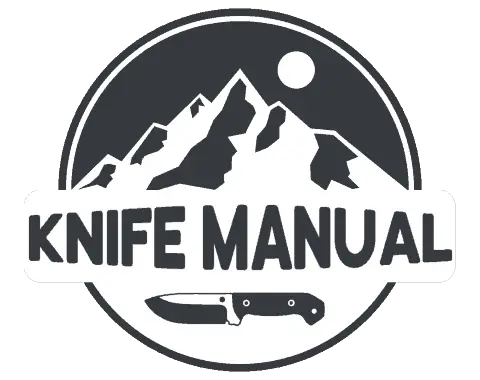As many knife enthusiasts know, there are two primary types of knife edges that you must choose from when picking a new knife: serrated or plain edge. The debate on which one is better has been going on for a LONG time, so let’s look at the arguments for both sides and figure out which one is truly better.
Serrated and plain edge knives are both useful, but they are meant to do very different tasks. Serrated blades are suitable for slicing or chopping rough materials, where serrations provide grip. On the other hand, plain edge knives are great for slicing and cutting precisely on smoother surfaces.
Both types of blades can be spectacular in particular situations, but that still doesn’t definitively answer which one is better than the other. We are going to need to dig a little deeper into the design of the two types of knife edges to figure this question out honestly.
So let’s dive right into it and discuss which blade type you should look for on your next knife, the benefits and disadvantages of each, and a few other things that are useful to know and could play a part in your final decision.
Table of Contents
Which is Better: Serrated Knives or Plain Edge Knives?
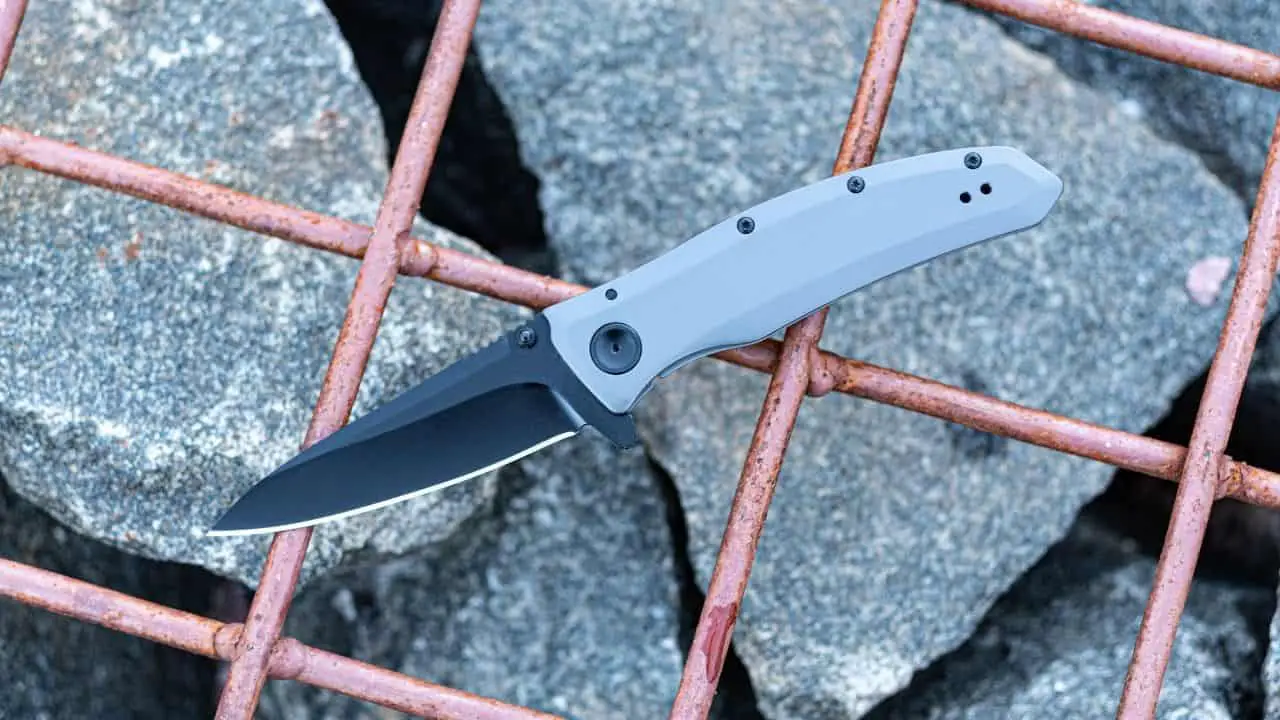
Serrated and plain edge knives are quite different in design (couldn’t you tell from the teeth on one and the absence of teeth on the other!), and they both serve a particular purpose. With this in mind, it is nearly impossible to have a subjective winner between the two because they are just not even meant to compete.
HOWEVER, when you purchase a knife, you will often need to decide between a serrated blade and a plain edge.
This question puts us in a complicated situation because it requires either serrated knives or plain edge knives to be better than the other, even though they are meant for different tasks.
Just looking at each type of blade’s pros and cons, plain edge knives are much more versatile and useful in everyday life. So, for someone looking for a new knife who doesn’t know what function they want that knife to serve, a plain edge blade is the best way to go.
There are many exceptions to this, but in general, most people will be much better off with a plain edge knife over a serrated one.
If you have a specialized need for your knife, then a serrated blade may come in useful depending on what it is you’re doing. But if you don’t have a specific task in mind or a personal opinion on the matter, a plain edge will give you more options and freedom when using your blade.
The Pros and Cons of Serrated Knives
As you can tell from the section above, I firmly think a plain edge knife has many more uses and much more versatility in most situations. However, let’s take an honest look at the pros and cons of serrated knives for a moment to try to answer the question, “are serrated knives better than plain edge knives?”
I think it is worth the time to take a look at the benefits and disadvantages of serrated knives to decide for yourself.
Benefits of Serrated Knives
While serrated knives are generally more specialized in what they can do, there are some pretty glaringly useful advantages to having a toothed blade on your knife. Here are some of the more significant benefits of serrated knives:
- Easily cuts through rough or hard materials
- Can grip onto and cut through slick materials
- They stay sharp for a long time
The above benefits of serrated knives are quite significant, especially if you often use your knife to do tasks that play to these strengths.
Serrated blades are great for cutting quickly through rough and hard materials. The serrations on the blade can dig into stiff materials and, when you move your knife blade, they obliterate and chew through the material with ease.
The serrations on a serrated knife are also particularly good at catching on slick or slippery materials, which gives more control to your cuts. In addition, serrated blades stay sharp for a VERY long time. You can use your serrated knife to cut through some pretty difficult materials, but it will remain sharp for a surprisingly long time.
Even when your serrated knife becomes dull after a lot of use, it will still be able to cut through many things reasonably well. Even when they are not razor-sharp, the serrations still dig into materials and can slice and cut.
Disadvantages of Serrated Knives
Serrated knives have many benefits, but there are actually some pretty essential disadvantages to them that you should keep in mind. Below are some of the major cons to serrated knives that you should definitely think about before getting one:
- Not versatile and only useful in select situations
- Super challenging to sharpen without the correct tools
- Often makes a very rough and uneven cut
None of the above cons to serrated knives should deter you from getting a knife with this type of blade if you genuinely need a tool that does what a serrated knife is meant to do. However, if you don’t know what you want your knife for, it is essential to consider the cons of serrated knives.
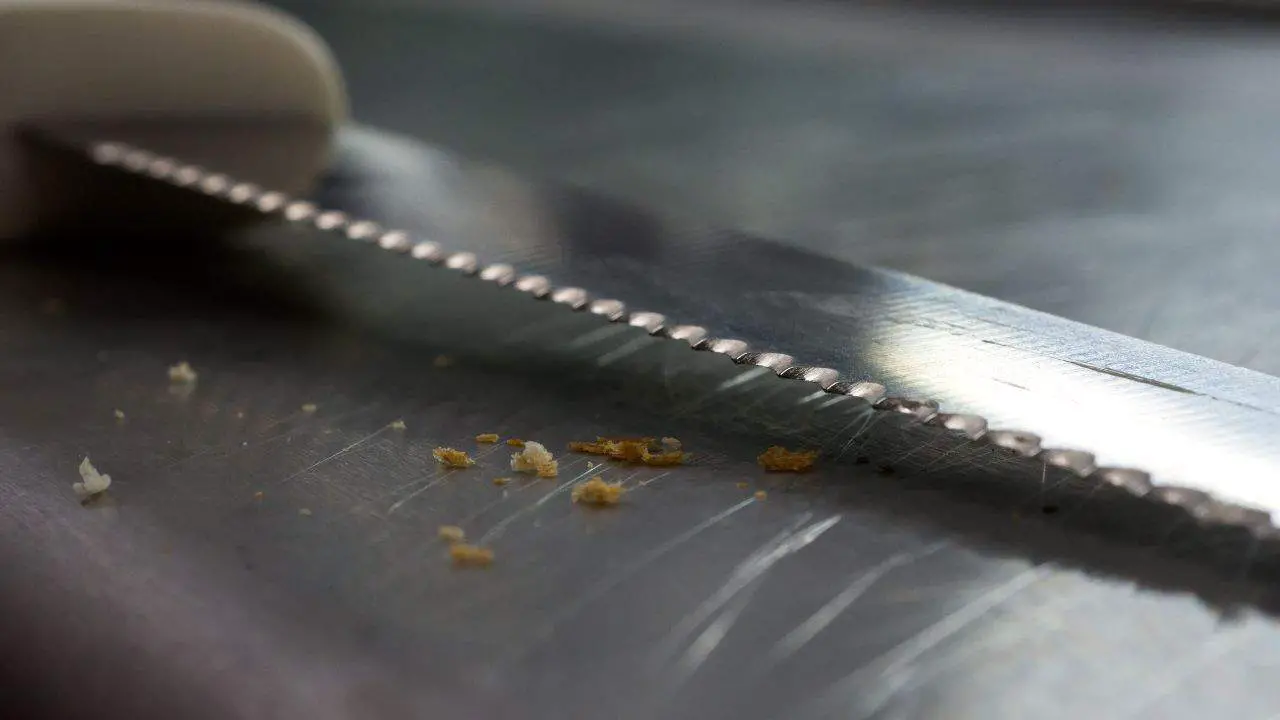
Serrated blades are generally less versatile overall and are only truly useful in a very select few situations. The teeth on the blade can get in the way in many cases, leading to slower completion of tasks. Overall, if you don’t have a specific need for a serrated knife, you’re likely better off with a combo or plain edge one.
Sharpening a serrated knife can also be very challenging and tricky. There are many serrated blade sharpening tools that you can get to help you out, but it takes time to learn and be capable enough to do well.
that you can get to help you out, but it takes time to learn and be capable enough to do well.
Another potential downside to serrated blades is the type of cut that they make in materials. Without a TON of precision and care, serrated blades will virtually “chew” through whatever material you are cutting. Uneven and rough cuts are acceptable in some situations, but it is something to keep in mind.
The Pros and Cons of Plain Edge Knives
Now that we’ve gone over the pros and cons of serrated knife blades, the obvious next step is to take a look at plain edge knives. Let’s try to answer the question, “are plain edge knives better than serrated knives?”
Below are my honest thoughts on the pros and cons of plain edge knives, so take a look and decide for yourself whether they are better than serrated knives or not.
Benefits of Plain Edge Knives
There are many benefits to having a plain edge knife, which often outweighs all of the cons. However, it’s best if you decide this for yourself and your particular situation, so below are some of the most significant pros to plain edge knives:
- Cuts cleanly and evenly through most materials
- Easy to make precise cuts
- Super easy to sharpen
- Very versatile and useful in many situations
Unlike serrations, plain edge knives don’t have any ridges or jagged edges on the blade, allowing them to cut super clearly through most materials. If you are push cutting through a piece of material, it is relatively easy to get a very even and consistent slice with a plain edge knife.
Delicate and precise cuts are also much more doable, and you can do them without too much extra effort due to the slender and maneuverable blade typical on plain edge knives.
Plain edged knives are also very simple to sharpen, even without much experience. Once you have the basics down, sharpening a plain edge knife becomes second nature. Even complete beginners often catch on quickly and can properly sharpen their plain edge knife pretty quickly.
Overall, plain edge knives are VERY useful in basic everyday situations and in even more extreme cases such as survival, self-defense, or hunting. Plain edge knives rarely become a hindrance and are generally much more versatile than serrated or even partially serrated knives.
Disadvantages of Plain Edge Knives
Knives with plain edges are some of the most popular knives out there, but there are some disadvantages to them. While they might seem small and insignificant, below are some of the biggest cons to plain edge knives:
- Need to be sharpened quite often
- Difficult to cut through tougher materials
- Prone to slipping and sliding when cutting
Compared to serrated knives, plain edge knives often need to be sharpened quite a bit more often. Granted, sharpening a plain edge knife is quite simple, but it is important to note that you might have to do it more often than you might like depending on the blade steel.
While plain edge knives are good at cutting nearly anything, one area where they struggle a little bit is tough and rigid materials. There are no teeth on a plain edge knife to dig into the tough material, which makes cutting a little more challenging.
Cutting certain materials such as rope, slippery materials, and extremely rigid materials can also cause another difficulty with plain edge knives: slipping. Since plain edge knives are incredibly smooth, you might experience some trouble with your blade slipping when cutting certain things.
Your blade slipping isn’t a massive problem because it will often catch on the material and allow you to cut, but it can be annoying and a potential disadvantage to plain edge knives.
Are Partially Serrated Knives a Better Option (Combo Edges)?
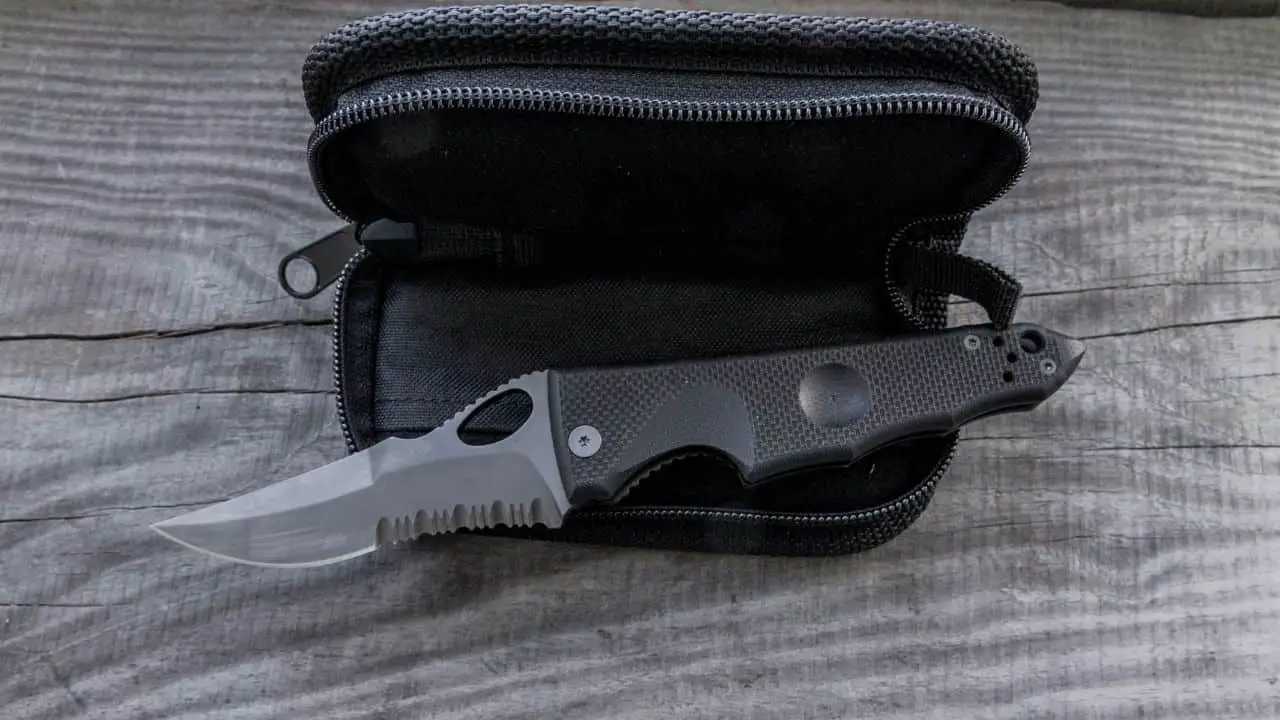
Both serrated knives and plain edge knives have their benefits and disadvantages, but there is a third option that is important to consider: partially serrated knives.
Partially serrated knives are a combination between a serrated and a plain edge knife, which is supposedly the best of both worlds. A typical partially serrated knife, or combo edge, has a serrated portion closest to the handle, while the rest of the blade is a plain edge.
But are partially serrated knives really better than serrated or plain edge knives?
Partially Serrated Knife Pros:
- Very versatile and convenient
- Saves you from having to carry two separate knives
- You’re able to cut through nearly any material consistency
Partially Serrated Knife Cons:
- Difficult to sharpen
- Each blade type is only a portion of the knife, which can make it can be challenging to use
Whether a partially serrated knife is the perfect compromise between a serrated and plain edge knife or not is still up for debate, but they do have some pretty convincing benefits. However, the disadvantages to partially serrated knives are also quite prominent, so it’s really up to you to decide whether a combo edge is right for you.
There is no actual winner between serrated, plain edge, and partially serrated knives because everyone has different needs and preferences, but personally, I prefer plain edge knives over everything else.
Types of Knives and Whether They Should Have a Serrated or Plain Edge Blade
There are many types of knives out there for different things, and most of them have serrated and plain edge options.
Obviously, I can’t cover EVERY SINGLE type of knife in existence, but let’s talk about some of the most common ones and explain what kind of blade they should have; either serrated or plain edge.
- Survival Knife: plain edge blades are usually best, but a serrated knife can be useful in select situations
- Self-Defense Knife: you can use either plain or serrated edge knives depending on your preferences
- Throwing Knife: plain edge knives are best and nearly exclusively used
- Hunting Knife: you will usually want a plain edge knife, although in select cases, a serrated blade can come in handy
- Everyday Carry Knife: plain edge knives are usually the most versatile and the best option
- Kitchen Knife: both plain edge and serrated knives are great, although you usually use them for separate tasks
- Wood Carving Knife: most of the time, a plain edge blade is best, but a serrated knife can come in handy sometimes
- Multi-Tool Knife: you can usually have both a plain and serrated blade, but a plain edge knife is usually best
Some people might disagree, and there are plenty of exceptions out there, but below I’ll go over different types of knives and talk about whether they should have a serrated or plain edge blade.
Survival Knife
In the vast majority of cases, survival knives should have a plain edge blade. Due to the nature of tasks that you often do in a survival situation, a serrated blade likely would just get in the way and cause more trouble than it’s worth.
There are many tasks and jobs that a survival knife has to handle, but some of the most common tasks are shelter building, tool creation, and food processing. None of these tasks would benefit from a serrated blade.
It’s not a hard and fast rule that survival knives shouldn’t be serrated, but it just makes the most sense in a lot of cases. For those who like serrated knives and use them a lot, a partially serrated blade can be a good option for a survival knife and is a nice compromise.
Make sure to check out my more in-depth article on whether a survival knife should have a serrated blade or not here!
Self-Defense Knife
When it comes to whether a self-defense knife should be serrated or not, there is quite a bit of room for debate because both options have their particular drawbacks and benefits. It primarily comes down to your personal defense style and preference to make a decision.
Serrated self-defense knives are super effective and can inflict very severe wounds without too much effort due to the many teeth on the blade that bury in the target and rip out when removed. However, serrations are also prone to get caught on fabric and can cause more difficulty than their added advantages are worth.
Personally, I would rather have a plain edge self-defense knife due to its versatility, ease of sharpening, and decreased chance of getting caught on clothing. However, each has its unique strengths and weaknesses, so it really comes down to what you like to carry and your preferences.
Throwing Knife
Most, if not all, throwing knives are plain edge. If you take a moment to think about how throwing knives are used and their core purpose, nearly all of them being plain edge makes a lot of sense.
While you can technically throw nearly any knife, good throwing knives are adequately weighted, well balanced, have a sleek and streamlined design, and easily stick into targets. It’s this last point that I would like to draw attention to because it is crucially important.
Serrations are great at sticking and holding onto materials, but when you throw a knife. It is super challenging to make a serrated throwing knife stick into a target, which is often made of wood. Instead, plain edge knives are usually the way to go because you’ll have much better luck getting them to stick into the target.
Hunting Knife
In the vast majority of cases, you’ll want your hunting knife to have a plain edge. The term “hunting knife” can include many types of knives that complete very different tasks, but only in rare cases will a serrated knife come in handy while hunting, cleaning, or preparing game animals.
As I mention in my article on qualities to look for in a skinning knife, a slender plain edge knife is crucial to cleanly and quickly skinning an animal. A serrated blade would just rip through the game and could potentially cause the meat to become spoiled.
A serrated knife could come in handy in very niche situations where you are cutting an animal into smaller pieces to carry back to camp or something similar where you don’t need precision or clean cuts. However, the VAST majority of the time, a plain edge hunting knife is the way to go.
Everyday Carry Knife
Everyday carry knives need to be useful in many situations, which leads most people to want them to have a plain edge blade. While useful in very select instances, serrated blades are not nearly as versatile as plain edge knives.
While it is far from the majority of people, some prefer a serrated everyday carry knife. If you are one of the rebels that finds a serrated blade useful, make sure to check out my article on ways to use a serrated pocket knife.
For most people, a serrated blade will not be handy, so it is best to go with a plain edge blade. A partially serrated blade, also known as a combo edge, can also be very nice to have on an everyday carry knife, especially if you find yourself wanting a serrated blade alongside the versatility of a plain edge.
Kitchen Knife
In the kitchen, knives serve a wide variety of purposes. Some tasks require serrated blades, and others need a plain edge. There is no single knife that can serve EVERY purpose while cooking, but a plain edge knife is often more versatile, so if you had to pick one, that would be it.
Professional and serious enthusiast cooks are very particular about their knives and what brand, steel, and blade type they are. But for most people who cook basic dishes every once and a while (like me!), a plain edge blade is much more useful than a serrated one.
Serrated blades come in really handy when you are cutting bread, fruit, and other specific foods that require serrations to be cut appropriately. A plain edge will get the job done, and if properly maintained and sharpened, will cut nearly anything you will come across in a kitchen.
Wood Carving Knife
For wood carving, a plain edge knife will usually be the best option. A plain edge blade allows you to cut much more precisely without chewing through the wood, and your cuts will be much smoother and controlled.
Wood carving is often made to seem overly complicated, but when you simplify it down, you only need to make two types of cuts for nearly any project: rough and precise. You often do rough cuts to carve out your project’s basic shape before doing any detailed and accurate work. Once you have your basic shape carved out of your wood, most projects will require you to do more precise touchups and additions.
Serrated blades work great for making rough cuts because they are good at chewing and sawing through wood. However, once you need any type of precision in your work, a plain edge blade will be your best bet.
While there are uses for both serrated and plain edge knives in wood carving, you can usually do everything you need to with a single plain edge blade.
Multi-Tool Knife
Much like an everyday carry knife, most people will find a plain edge blade much more useful on their multi-tool than a serrated one. As I have said a million times, plain edge knives are much more versatile, and that is what you usually are looking for in a multi-tool blade anyway, so it makes a lot of sense.
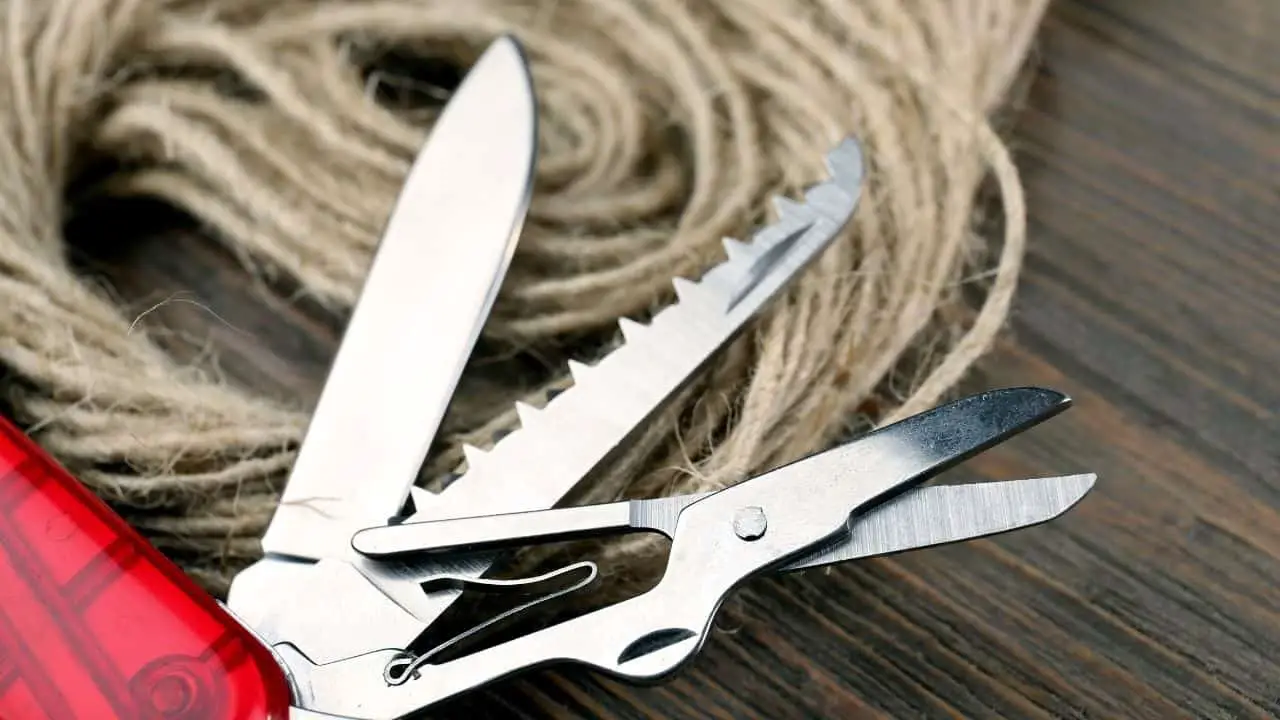
One benefit to multi-tools is their capacity to have two or more blades. You could even carry around a multi-tool with a serrated blade AND a plain edge one if you would like. It’s like the versatility of a combo edge, but without any of the usual drawbacks, such as each section of the blade being too short!
However, if it came down to choosing only a single blade to have on a multi-tool, it would be a plain edge blade without a doubt.
Which Type of Knife Blade to Use for Different Cutting Motions
Now that we’ve covered many of the significant types of knife categories and whether they should have serrated or plain edge blades, let’s take a look at the different cutting motions you can do with a knife.
- Slicing: plain edge knives are essential due to their ability to cut through material in a single, smooth motion
- Cutting: for both push and pull cutting, a plain edge blade is the safest and best option out there
- Sawing: serrated knives are perfect for the job because of their grippy and tough teeth
- Chopping: while you should chop with your knife only when there are no other options, a plain edge knife is best for the tas
Slicing
Slicing relies on the knife blade’s smoothness and sharpness to cut through material in a single, smooth motion. Serrations are the exact opposite when it comes to smooth cuts, which is why you’ll want a plain edge blade if you intend to slice any sort of material.
Cutting
Both push and pull cutting need the blade to glide as smoothly as possible through whatever material you are cutting. Plain edged knives are perfect at this, while serrated blades would get stuck and not cut smoothly in the slightest.
Sawing
Sawing is one of the few knife motions where a serrated blade is ideal. Plain edge knives tend to slip and slide around when you try sawing with them, while serrated blades can grip onto the material and get the job done quickly.
Chopping
Due to its ability to break or harm nearly all types of knife blades, you should only chop with your knife when there is no other option. However, in the rare cases where you need to chop with your knife, a plain edge is your best bet. Serrated knives will often get caught in whatever material you’re chopping and can significantly slow down the completion of tasks.
Serrated, plain edge, and combo edge knives can be extremely useful, so if you are looking to pick one up for yourself, make sure to check out my recommendations below!
